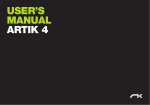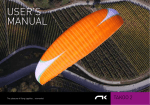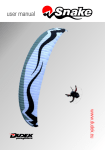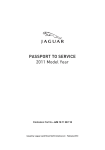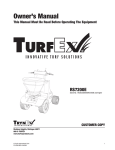Download USER`S MANUAL DOBERMANN
Transcript
USER’S MANUAL DOBERMANN DOBERMANN Paramotor Freestyle Slalom NIVIUK Gliders DOBERMANN WELCOME This manual offers all the necessary information that will familiarize you with the main characteristics of your new paraglider. Although this manual informs you about your glider, it does not offer the instruction requirements necessary for you to be able to pilot this type of wing. Flying instruction can only be taught at a paragliding school recognized by the Flying Federation of your country. We wish to welcome you to our team and thank you for the confidence that you have placed in a NIVIUK Glider. We would like to share with you the commitment, the passion and emotions of the Niviuk design team, which have resulted in the creation of the new DOBERMANN. Niviuk are very proud of this new glider, a glider carefully designed to bring you maximum pleasure whilst allowing you learn and progress. The DOBERMANN is a gratifying wing to be enjoyed in freestyle and slalom activities. With its friendly flying behavior and various sizes availability, it meets the needs of pilots who enjoy racing, participate in slaloms circuits, speed and air games. We are confident that you will enjoy flying this wing and that you will soon understand the meaning of our slogan: “The importance of small details” This is the user’s manual that we recommend you to read in detail. The NIVIUK Gliders Team. NIVIUK GLIDERS & AIR GAMES SL C/ DEL TER 6, NAVE D 17165 LA CELLERA DE TER - GIRONA - SPAIN TEL. +34 972 42 28 78 FAX +34 972 42 00 86 [email protected] www.niviuk.com 2 USER’S MANUAL Nevertheless we remind you that it is important that you carefully read all the contents of the manual for your new DOBERMANN. Severe injuries to the pilot can be the consequence of the misuse of this equipment. SUMMARY WELCOME2 4. IN FLIGHT 11 USER’S MANUAL 2 4.1 FLYING IN TURBULENCE 11 1. CHARACTERISTICS 4 4.2 POSSIBLE CONFIGURATIONS 12 1.1 WHO IS IT DESIGNED FOR? 4 4.3 USING THE ACCELERATOR 13 1.2 CERTIFICATION 4 4.4 FLYING WITHOUT BRAKE LINES 13 1.3 IN-FLIGHT BEHAVIOUR 4 4.5 KNOTS IN FLIGHT 13 1.4 ASSEMBLY, MATERIALS 5 5. LOSING HEIGHT 13 1.5 ELEMENTS, COMPONENTS 6 5.1 EARS 13 1.6 PROFILE 6 5.2 B-LINE STALL 14 2. UNPACKING AND ASSEMBLY 6 5.3 SPIRAL DIVE 14 2.1 CHOOSE THE RIGHT PLACE 6 6. SPECIAL METHODS 14 2.2 PROCEDURE 7 6.1 TOWING 14 2.3 ASSEMBLY TO THE ENGINE 7 6.2 ACROBATIC FLIGHT 14 2.4 ASSEMBLY OF THE ACCELERATOR 7 7. FOLDING INSTRUCTIONS 14 2.4.1 ACCELERATION SYSTEM USE 7 8. CARE AND MAINTENANCE 14 2.5 TRIMMERS 8 8.1 MAINTENANCE 14 2.5.1 IN FLIGHT 8 8.2 STORAGE 15 2.5.2 LANDING 8 8.3 CHECKS AND CONTROLS 15 2.5.3 THE COURSE CORRECTOR (CC) 9 8.4 REPAIRS 15 2.6 ADJUSTING THE BRAKES 9 9. SAFETY AND RESPONSABILITY 15 2.7 DES (DOUBLE EFFECT SYSTEM) 9 10. GUARANTEE 15 11. TECHNICAL DATA 16 11.1 TECHNICAL DATA 16 3. THE FIRST FLIGHT 10 3.1 INSPECTION AND WING INFLATION ON THE GROUND 10 11.2 MATERIALS DESCRIPTION 17 3.2 CHOOSE THE RIGHT PLACE 10 11.3 RISERS PLAN 18 3.3 PREPARATION 10 11.4 SUSPENSION PLAN 19 3.4 PRE-FLIGHT CHECK LIST 10 11.5 DIMENSIONS DOBERMANN (14) 20 11.6 DIMENSIONS DOBERMANN 16 20 3.5 WING INFLATION, CONTROL, AND TAKE-OFF 10 11.7 DIMENSIONS DOBERMANN 17 21 3.6 LANDING 11 11.8 DIMENSIONS DOBERMANN 18 21 11.9 CERTIFICATION SPECIMEN TEST 22 3 1. CHARACTERISTICS 1.1 WHO IS IT DESIGNED FOR? The DOBERMANN is an advanced paraglider designed to be used in all forms of PPG flights but especially targeting experienced pilots looking for either a faster, sturdier competition wing or simply enjoy leisurely fun. Powered flight is a relatively new discipline and continues to evolve at a rapid pace. It is essential to obtain the maximum performance and the full potential of the DOBERMANN that the whole equipment package including the engine, propeller and harness are all suitable and fit for purpose. 1.2 CERTIFICATION The DOBERMANN passed the certification according to EN 926-1 rules. This test was carried out in the Swiss Air-Turquoise laboratories in Switzerland. Collision test of 1.000 kg. Load test 8g 145 kg. Load test 6g 193 kg. Load test report EN 926-1:2006 & LTF 91/09 It also passed the D.G.A.C certification as ULM class 1. And, the manufacturer’s certification. Any alteration of the paraglider can invalidate all the aforementioned certifications. numerous adjustments were made. These prototypes were then tested in all types of flight conditions. This intense development work supported by the combined experience of the whole team has achieved a wing with unbeatable behaviour.. The aim and objective of our new Niviuk Reflex Profile (RSP) was to achieve a profile with better performance than any other current reflex profile. In doing so we have applied many years of research and design knowledge with the addition of Niviuk advanced aerodynamic vision. The addition of the SLE and RAM Air intake technologies with its light weight and structured cells ensures that every inflation and take off remains simple and uneventful. Thanks to the DOBERMANN ’s controlled and progressive inflation rate the pilot remains in complete control of the wing throughout all stages of takeoff, which when compared to current profiles allows extra time to position the wing in the perfect pre-launch position, directly above the head. The running phase is perhaps one of the most critical when taking off with a powered wing, so any technological assistance is an advantage. On takeoff and in order to create sufficient lift traditional reflex profiles demand high forward speed, in other words, a long and fast run. The new Niviuk RSP on the DOBERMANN facilitates early lift and take-off so reducing the amount of time and physical effort required when running. Once airborne, the DOBERMANN remains precise and balanced to every pilot input and thanks to the new Niviuk Reflex System Profile(RSP) and the addition of finely evolved (SLE) Structured Leading Edge,the same innovative structure technology as used on our highly successful competition wings, the discipline of powered flight can now experience a PPG reflex profile capable of higher speeds with high security 1.3 IN-FLIGHT BEHAIVOR The NIVIUK Team has carried out extensive and meticulous design work. As a consequence of several prototypes and many hours of test flights 4 It will very quickly become apparent to the pilot that the handling and manoeuvrability of the DOBERMANN remains light and efficient during all aspects of flight and even in the most adverse conditions every pilot input is met with an immediate and precise response. Please read section 2.8 Adjusting the brakes. Every adjustment of the trimmers will each time transform the wing and by releasing them the DOBERMANN will feel more pressurised and solid, penetrating the different layers of laminar air, absorbing turbulence while increasing stability and reducing the roll. Please read section 2.7 Trimmers. In comparison with other reflex profiles the speed/consumption ratio is far better with the Niviuk RSP Its cruising speed and fuel consumption are excellent attributes for the lovers of long journeys. If the decision is to fly for long periods at maximum speed then the fuel consumption will reflect that of other profiles. The DOBERMANN has the same advantages when landing as it does on take-off. With a low speed approach, a short final glide and with the pilot always in total control the DOBERMANN can land in the smallest of areas with precision and ease. It is worthwhile remembering that the best paraglider in the hands of a bad pilot does not guarantee a happy ending. The DOBERMANN passive safety measures should also be accompanied by the passive safety offered by the rest of the flying equipment. The harness, helmet the emergency parachute etc. The extraordinary behaviour of the DOBERMANN and common-sense piloting will give you many hours of peaceful flying. in the same meticulous way so avoiding errors in this critical process. It may be a surprise for some pilots to learn that the lines used on the DOBERMANN are not the standard larger diameter lines which are normally associated and used as standard on PPG wings but in fact lines similar in diameter to those used on classic free flying, none powered wings. The old argument of thicker lines equals more strength and power is absolutely the opposite principle to achieving efficient profiles of flight. Niviuk believe that every aerodynamic improvement should be researched, assessed and if appropriate incorporated within a design. The latest advances in line technology have been researched and applied to the DOBERMANN allowing lighter smaller diameter lines to be used with improved aerodynamic efficiency but without any reduction in strength or overall security. The lines are semi-automatically manufactured and all the sewing is finished under the supervision of our specialists. The jigsaw puzzle of the assembly process is made easier using this method. We economise on resources while making the quality control more efficient. All the different parts of the canopy are cut and assembled under the strict conditions induced by the automation of the whole process. All NIVIUK Gliders go through an extremely thorough and efficient final inspection. Every single line of each glider is measured individually once the final assembly has concluded. Each wing is thoroughly inspected at the end of it assembly. Each glider is packaged following the maintenance and conservation instructions recommended for the advanced materials. 1.4 ASSEMBLY, MATERIALS The DOBERMANN does not only introduce new design methods but also new manufacture technologies. Not a single millimetre of error is possible in the manufacturing process from Olivier’s computer to the cutting of the fabric. The cutting is done section by section in an extremely meticulous manner. The numbering and marking of the guideline marks is also done NIVIUK Gliders are made of first class materials as demanded by the performance, durability, and homologation requirements of the presentday market. Information about construction materials is given on the last pages of this manual. 5 1.5 ELEMENTS, COMPONENTS The DOBERMANN is delivered to its owner together with a series of components that, although not fundamental, do take an important part in the use, transport and storage of the paraglider: -The new large capacity Kargo rucksack 175 L. Capacity and comfort all in one. -A folding bag to protect the wing when packing and carrying. -An adjustable strap for quick and easy compression to fold the wing as small as possible. -A small fabric repair including auto adhesive rips top (same colours of the wing) and replacement maillon blockers. 1.6 PROFILE The DOBERMANN project demanded a profile which would achieve PPG efficiency above all others taking powered flight forward and into the future. The new profile not only advances the understanding of aerodynamics and efficiency but also allows the reduction of surface area and the materials used. Its ability to inflate is extraordinarily easy, thus eliminating the need for high speed during takeoff and landing. This huge advantage basically resulted from the RAM Air Intake technology used for the first time in Paramotor design. The RAM Air Intake permits to reach an optimal air inflow configuration (below the glider’s leading edge aligned with the intrados) to obtain a rapid, progressive, stable inflation. This profile modification results in more comfortable faster and tighter glider turns. Another strong point in the DOBERMANN is the evolution of the Reflex System Profile (RSP). This innovation works together with the previous design to improve gliding, speed and safety. In addition, it cuts down 6 on fuel consumption: less engine power is needed to obtain the same performance level, so you can set your own limits. • The leading edge is outfitted with SLE and RAM Air Intake. • The DOBERMANN inflates easily and immediately ensuring only short low speed runs are necessary to take off. • Once airborne the trim system allows easy and precise adjustment to achieve cruising speeds substantially higher than the average in the PPG category. • The trim system has easy read metric markers to allow accurate and symmetrical adjustments. • The highly efficient Niviuk Reflex System Profile (RSP) unlike conventional reflex profiles requires less power to speed ratio so significantly reducing fuel consumption whilst cruising. • The new and efficient profile of the DOBERMANN enables the wing to glide through the air mass with very little resistance. • The SLE and RAM Air Intake ensure a solid leading edge in all conditions and is highly resistant to deflations. • The RSP maintains a constant airflow enhancing the efficiency of the trim system. • A significant reduction in the total number of lines reduces parasite drag adding to the improvement of fuel consumption and optimising the thrust. • During acceleration the DOBERMANN will remain on an equal axis experiencing minimum torsion influence from the rotational forces of the propeller. • During all manoeuvres the handling and turning remain smooth, precise and dynamic yet completely predictable and balanced throughout. • High stability throughout the wide speed range allowing confident slow low level flights to high altitude high speed cruising. 2. UNPACKING AND ASSEMBLY 2.1 CHOOSE THE RIGHT PLACE We recommend that you unpack and assemble your wing on a schooling slope or a flat clear area without too much wind and free of obstacles. These conditions will allow you to carry out all the steps required for you to check and inflate the DOBERMANN. correct use. This will vary according to the length of the pilots’ legs! We recommend that you try the correct fitting of the acceleration system on equipment designed to do this, most paragliding schools have this sort of equipment. We recommend that an instructor or a retailer supervise the entire procedure, as only they are competent to resolve any doubt in a safe and professional way. Warning: It is really important to securely fasten and keep the accelerator away from the propeller. 2.2 PROCEDURE 2.4.1 ACCELERATION SYSTEM USE Take the paraglider out of the rucksack, open it and spread it open with the lines on top of the underside, position the wing as if you were to inflate it. Check the condition of the fabric and the lines, making sure there are no abnormalities. To accelerate, the pilot’s legs must be extended to push on the accelerator bar. To decelerated, the pilot ‘s legs must be relaxed to return to the initial neutral position. Check the maillons, which attach the lines to the risers are properly closed. Identify and if necessary disentangle the lines from A, B, C and D risers, the brake lines and the corresponding risers. Make sure that there are no ties or knots. Pilots are fully responsible for their own action when taking the decision to accelerate in flight. The acceleration system does not uniformly increase or decrease the glider.’s air speed. The following information has to be taken in consideration:n order to accelerate, the pilot should extend his/her legs while having the feet resting on the acceleration bar. In order to decelerated, the pilot should flex his/her legs to reach the initial position. 2.3 ASSEMBLY TO THE ENGINE After carefully laying out the wing connect the risers to the harness/ engine according to the paramotor manufacturer instructions. Pilots are ultimately responsible for the acceleration method chosen while flying. The speed bar is not the only way to increase or decrease the speed of the glider. The following information has to be taken in consideration: 2.4 ASSEMBLY OF THE ACCELERATOR The acceleration mechanism of the DOBERMANN works when you push with your feet on the accelerator bar. Most harnesses designed for powered flight are equipped with a preinstalled acceleration system. When fitting any accelerator system ensure that all preinstalled items within the harness, such as roller pulleys are used correctly. After fitting, take into account that you will have to adjust the length of the accelerator lines for accelerator 100% 100% 0% trimmers 100% 0% 100% brake 0% 100% 100% c.c ok ok ok This chart shows the maximum acceleration system in flight conditions. Windspeed increase and air turbulence should be considered by the pilot 7 before deciding whether or not implement the maneuver safely. 2.5.1 IN FLIGHT 2.5 TRIMMERS The trimmers on the DOBERMANN are highly and precisely adjustable allowing the pilot to either increase speed by opening the trimmers or conversely decrease speed by closing them. Use of the trimmers: The trimmers are a system to modify glider profile. To activate them the pilot should gently push the “trimmers” metal buckles to allow straps movement. Release the metal buckles to lock the straps at the desired setting. Pilots call this action “trims tightening and release”. To tighten the trimmers, the pilot should pull the straps down vertically without manipulating the metal buckles. Trimmers must work symmetrically and unison. Takeoff: The trimmers can be used during all aspects of any flight but thanks to the profile of the DOBERMANN they are of special help during takeoff. The RAM system pre-positions the open cells of the leading edge in the best possible way assuring a rapid formation the wing profile. This contribution is in itself already a huge advantage when attempting to take off in nil wind conditions but the correct use of the trimmers at this time with further enhance an easy take-off. In nil wind and without the application of trimmers the DOBERMANN inflates easily and effortlessly. However by adjusting the trimmers we can control both the inflation and the speed at which the wing rises. We should not confuse the speed of the inflation with the speed of the forward run required. It is important to remember that the minimum take-off speed is achieved with the trimmers closed and as the trimmers are opened more speed will be required. Therefore every pilot should be aware of the trimmer settings and make any necessary adjustments appropriate to the conditions, the terrain and pilot ability. 8 Each trimmer is equipped with a scale clearly numbered so allowing the pilot to easily check and confirm the exact setting of each. Each trimmer may be set to compensate for the torque effect of the engine allowing fine tuning to ensure the wing remains in symmetrical flight. The pilot will very quickly become familiar with the scale and after just a few flights be able to optimise every flight by adjusting the trimmers to their most efficient setting. The RSP operates at its highest level of efficiency with the trimmers released so allowing maximum forward wing speed. Logic dictates that if the main objective is maximum performance and high speed then the increased use of the engine throttle will decrease the fuel efficiency. The RSP however, works extraordinary well and is ahead of other reflex profiles. When the trimmers are half open it offers improved performance/fuel consumption over other reflex profiles. With less power and therefore less fuel consumption the DOBERMANN achieves superior PPG performance. With the trimmers closed and using just the full range of brake travel the DOBERMANN is a precise, light to handle and a fun machine to fly. 2.5.2 LANDING The new Reflex System Profile (RSP) with the trimmers closed almost morphs the DOBERMANN into a free flight wing allowing a slow approach speed and the flight to end with the perfect landing , large areas and long runs are no longer required. It must be remember that in wind nil conditions the forward ground speed encountered may be significantly higher and during landing that speed must be decreased as safely as possible. This can be achieved by fully closing the trimmers and proportionately applying the brakes. If necessary as the pilot reaches the ground a longer run off should also be carried out. When landing in moderate wind conditions, the ground speed is reduced so simple and progressive application of the brakes will be enough for a perfect landing. Landing with open or half open trimmers is possible, but it will be necessary to balance the application of the brakes to the position of the trimmers and the forward ground speed being experienced. Of course open trimmers and an increase in forward ground speed when landing may require a larger landing area as opposed to when the trimmers are closed. The DOBERMANN very efficiently transforms forward speed into lift and inherently allows a wide margin for error either with or without wind. due to possible specification differences brought by various paramotor types, those settings can be adjusted to meet pilot needs. Warning! Remember that once the trimmers are in open position the distance from the pilot to the pulleys is increased, and glider control can be lost if the brakes/toggles are no longer hand held. If at any point you wish to change the length of the brake lines, simply untie the knot, slide the line through the brake link to the desired length, and strongly re-tie the knot.The brake line must always pass through the pulley. Recommended knots are the clove hitch knot or bowline knot. Both brake lines should be symmetrical in length taking in consideration the length when using the trimmers. It is then vital that the adjustments are checked to ensure that they do not slow down the glider without any pilot input. However it is recommended that only qualified personnel should carry out this adjustment. 2.5.3 THE COURSE CORRECTOR (CC) 2.7 DES (DOUBLE EFFECT SYSTEM) With DOBERMANN the CC is connected to the brakes to make it easier and more efficient to use and more efficient. This new positions allows pilots to activate and control it using only one element without changing the hand position when turning. The Course Corrector permits small course changes without altering the profile’s performance. The same situation takes place when turning, with pilots using the CC to start a turn or modify its course. The latter can be useful to those who like slalom racing around pylons. The CC is easy to use. It was installed with the brakes but does not run through the pulleys, thus letting the pilot roll the line up without pushing the brakes. To roll it up completely just stop pushing it. 2.6 ADJUSTING THE BRAKES The main brake line length is adjusted at the factory to meet with the certification requirements. during the certification procedure. However, WARNING – This technique must only be used by experienced pilots during slalom competitions. Please, be also aware that using the system while flying close to the ground demands defensive/aggressive flying and accurate wing control in case of glider instability. During slalom competitions pilots need to slow down to the lowest speed to turn around the pylons. Brake impute is adapted on the fly when immediate accelerations and decelerations are needed to efficiently navigate the turns. The trims can not be used during the race while quick accelerations or decelerations can only be made by using the foot speed-bar/accelerator. The implementation of the DES has turned the situation around. The pilot can now make the most out of the glider’s ability to perform to its full potential by using the speed bar. The DES keeps the trims in a closed position (the slowest) by default, and will open them when accelerating 9 during the flight. When the accelerator is released, the DES brings the profile back to the neutral and default position. The correct placement of the wing on the ground prior takeoff is very important. Select an area free from debris or obstruction and suitable for the direction of the wind. We recommend placing the wing on the ground in a semi circular or shoe horse shape. 3. THE FIRST FLIGHT 3.4 PRE-FLIGHT CHECK LIST 3.1 INSPECTION AND WING INFLATION ON THE GROUND Once all the equipment has been thoroughly checked and the wind conditions are favourable, inflate your DOBERMANN as many times as necessary in order to become acquainted with the wings behaviour. The DOBERMANN inflates easily and smoothly. An excess of energy is not necessary and the wing will inflate with minimum pressure on the harness when you move forward. This may be assisted by using the A lines. Do not pull, merely support them as they rise naturally with the movement of the wing. Once the wing is in the 12 o’clock position, simply apply correct pressure on the brake lines and the DOBERMANN will sit over your head. Again we remind all pilots that this manual offers all the necessary information that will familiarise you with the main characteristics of your new paraglider. Any information, detail or specification relating to the power source itself must be obtained from the manufacturer of the paramotor. Check that the current and future meteorological conditions of the day are within the parameters of your own flying experience and ability. Secure your helmet and individually check each of the maillons ensuring they are all properly and securely closed. Ensure the engine can easily achieve full thrust, the level of fuel is appropriate for your flight and the rescue system is secure and unhindered. 3.2 CHOOSE THE RIGHT PLACE We recommend that the first flight with your DOBERMANN is made on a smooth slope or in your usual flying area. Once ready and immediately prior to takeoff a final visual check of the equipment and all attachments must be carried out. Checking the lines unwanted knots and that the trimmers are at the correct setting for takeoff. 3.3 PREPARATION 3.5 WING INFLATION, CONTROL, AND TAKE-OFF For the preparation of the wing, please repeat the method shown on the chapter 2, Unpacking and Assembly. Taking off on Foot or using a Trike the DOBERMANN does not require a different technique for each. The control of the DOBERMANN is intuitive and the wing inflates easily and progressively in a controlled manner. Any unwanted oscillation or required course correction can easily be controlled with gentle pilot input Check the condition of the fabric and the lines, making sure there are no abnormalities. Check the maillons, which attach the lines to the risers are fully closed. Identify and if necessary disentangle the lines from A, B, and C risers, the brake lines and the corresponding risers. Check for no ties or knots. 10 When the decision has been made to takeoff only a short run is required and the DOBERMANN will quickly transform the forward speed and thrust of the engine into lift. Even with the Trike only a very short rolling distance is required to achieve the desired forward lift speed of 25 km/h and take off. The DOBERMANN has been designed to easily and efficiently inflate whilst providing exceptional directional stability without pitching or hanging back behind the pilot. Excessive amounts of energy are not required when taking off with the Kougar, simply set the trimmers to the correct positions (see 2.7) and gently lift the risers whilst gaining forward momentum. Taking off in nil wind conditions is not a problem for the DOBERMANN. 3.6 LANDING The new Reflex System Profile (RSP) with the trimmers closed almost morphs the DOBERMANN into a free flight wing allowing a slow approach speed and the flight to end with the perfect landing. Large areas and long runs are no longer required. It must be remember that in nil wind conditions the forward ground speed encountered may be significant and during landing must be decreased by using the brakes and if necessary by a longer run off as the pilot makes contact with the ground. When landing in moderate wind conditions, the ground speed is reduced so simple and progressive application of the brakes will be enough for a perfect landing. Landing with open or half open trimmers is possible, but it will be necessary to balance the application of the brakes to the position of the trimmers and the forward ground speed being experienced. Of course open trimmers and an increase in forward ground speed when landing may require a larger landing area as opposed to when the trimmers are closed. The DOBERMANN very efficiently transforms forward speed into lift and inherently allows a wide margin for error either with or without wind. 4. IN FLIGHT It is important to stress that the reaction to the manoeuvres is different in each wing size, and even the reactions and solutions to each manoeuvre are different on the same size wing when the overall loading (i.e. Pilot/ harness Weight/ wing load). Having known the aforementioned facts, pilots will be able to face different situations more appropriately. The greater the wing loading, the lesser the incidence rate; but the glider will react more abruptly. In terms of piloting the wing, the main toggles are more flexible and progressive, enabling for better glider control without excessive effort. An additional toggle system, connected to the stabilizer, improves glider management during accelerated flights and turns. The DOBERMANN can be steered with the trims opened while keeping the profile stable. In other words; maintaining a high wing internal pressure with extraordinary leading edge rigidity at high speed. The glider turns without losing its handling flexibility nor its stable flight characteristics. 4.1 FLYING IN TURBULENCE The DOBERMANN comfortably absorbs moderate turbulence in either normal or accelerated flight, minimising any bouncing effect which is often experienced with other reflex profiles. Over handling Most flying incidents are caused by incorrect actions of the pilot, which chained one after another creates abnormal flying configurations (a cascade of incidents). You must to remember that over handling the wing will lead to critical levels of functioning. The DOBERMANN is designed always to try to recover normal flight by itself, do not try to over handle it. Generally speaking, the reactions of the wing, which follow over handling, are neither due to the input made or the intensity, but the length of time the pilot continues to over handle. You have to allow the profile to reestablish normal flight speed after any type of handling. 11 The most important safety and security feature of every glider is the pilot. risking a frontal collapse close to the ground. 4.2 POSSIBLE CONFIGURATIONS Parachutal stall Do not implement this manoeuver with the DOBERMANN. The following indications should be viewed as purely informative, solely relevant to normal flying settings, and can not to be considered nor viewed as a paragliding teaching manual. Only professional paragliding schools can teach and prepare pilots to do all these maneuvers. Asymmetric collapse The collapse will normally open by itself but if that does not happen, pull completely on the brake line on the side, which has collapsed. Do this with a firm movement. You may have to repeat this operation to provoke the re-opening. Take care not to over brake on the side that is still flying (turn control) and when the collapse has been solved; remember to let the wing recover its flying speed. Symmetric collapse A symmetric collapse may occur in heavy turbulent conditions, on entry or exit of strong thermals or lack of adapting the use of the accelerator to the prevailing air conditions. If a symmetrical collapse does not recover on it’s own, you can symmetrically apply the brake lines with a quick deep pump to quicken the re-inflation. Release the brake lines immediately to recover optimum flight speed. Negative spin This configuration is out of the normal flight behaviour of the DOBERMANN. Remember that you should restore the relative air speed over the wing. To achieve this, progressively reduce the pressure on the brake lines and let the wing gain speed. The normal reaction would be a lateral surge with a turn tendency no greater than 360º before restoring to normal flight conditions. Next to the ground or slalom racing around pylons, the situation is critical, and thus recommended to keep the negative turn in control rather than 12 Deep stall The glider will first fall behind you and then situate itself above you, rocking slightly, depending on how the manoeuvre was carried out. When you start to provoke a stall, be positive and do not doubt an instant. Do not release the brake lines when half way through the manoeuvre. This would cause the glider to surge violently forward with great energy and may result in the wing below the pilot. It is very important that the pressure on the brake lines is maintained until the wing is well established vertical above. Wing tangle A wing tangle may happen after an asymmetric collapse. The correction manoeuvres are the same as those applied in the case of an asymmetrical collapse, control the turn by applying pressure on the opposite brake and reopening the wing using the stabilizer lines. Extreme awareness and caution should be of utmost importance when flying in turbulent conditions. Be careful when attempting to undo a tangle if you are flying near a mountainside or near to other paragliders, you may lose control of the flying course and a collision may occur. 4.3 USING THE ACCELERATOR The profile of the DOBERMANN has been designed to fly stable through its entire speed range. If you feel a pressure loss, you should release the pressure on the accelerator and pull slightly on the brake lines to increase the angle of incidence. Remember that you have to re-establish the flight speed after correcting the incidence. It is NOT recommended to accelerate near to the mountainside or in very turbulent conditions. If necessary you will have to constantly adjust the movements and pressure on the accelerator whilst constantly adjusting the pressure applied to the brake lines. This balance is considered to be “active piloting.” If we choose to fly with the trimmers opened while using the accelerator caution should be heightened in turbulent air conditions. 4.4 FLYING WITHOUT BRAKE LINES Before trying to remove a knot, make sure there are no pilots flying nearby and never try these manoeuvres near the mountainside. If the knot is too tight and you cannot remove it, carefully and safely fly to the nearest landing place. 5. LOSING HEIGHT If, for any reason at all, you cannot use the brake lines of your DOBERMANN you will have to pilot the wing using the d-risers and your body weight to fly towards the nearest landing. The D-lines steer easily because they are not under pressure; you have to be careful not to over handle them causing a stall or negative turn. The trimmers must first be rolled-up before landing, and let the wing fly at full speed and before reaching the ground you will have to pull symmetrically on both the D-risers. The knowledge of the different descent techniques is an important resource to use in certain situations. The most adequate descent method will depend on the particular situation. This braking method is not as effective as using the brake lines so you will land at a higher speed. 5.1 EARS 4.5 KNOTS IN FLIGHT The best way to avoid these knots and tangles is to inspect the lines before you inflate the wing for take-off. If you notice a knot before takeoff, immediately stop running and do not takeoff. If you have taken-off with a knot you will have to correct the drift by leaning on the opposite side of the knot and apply the brake line on that side too. You can gently try to pull on the brake line to see if the knot becomes unfastened or try to identify the line with the knot in it. Try to pull the identified line to see if the knot undoes. Be very careful when trying to remove a knot. When there are knots in the lines or when they are tangled, do not pull too hard on the brake lines because there is an increased risk of the wing to stalling or negative turn being initiated. The following indications should be viewed as purely informative, solely relevant to normal flying settings, and can not to be considered nor viewed as a paragliding teaching manual. Only professional paragliding schools can teach and prepare pilots to do all these maneuvers. Big ears is a moderate descent technique, achieving about –3 or –4 m/s and a reduction in ground speed of between 3 and 5 km/h. Effective piloting then becomes limited. To apply ears select the outermost A-line from each stabilizer as high up as possible and pull them outward and downward in a smooth and symmetrical motion. The wingtips will then fold inwards. Releasing the lines will see the wingtips re-inflate automatically. If they do not re-inflate, gently pull on one of the brake lines and then on the opposite side. We recommend that you re-inflate asymmetrically, this will reduce the risk of altering the angle of incidence which should be avoided, more so if you are flying near the ground or flying in turbulence. 5.2 B-LINE STALL When you carry out this manoeuvre, the wing stops flying, it loses all 13 horizontal speed and you are not in control of the paraglider. The air circulation over the profile is interrupted and the wing enters into a situation similar to parachuting. Although the DOBERMANN has been tested by expert acrobatic pilots in extreme situations, it HAS NOT been designed for acrobatic flight and we DO NOT RECOMMEND THE USE OF THIS GLIDER for that use. 5.3 SPIRAL DIVE We consider acrobatic flight to be any form of piloting that is different to normal flight. Extreme manoeuvres take you and your wing to centrifugal forces that can reach 4 to 5 g. Materials will wear more quickly than in normal flight. This is a more effective way for rapidly losing height. You have to know that, the wing can gain a lot of speed and the increase in G’s will be substantial. This can cause a loss of orientation and consciousness (blackouts). These are the reasons why it is best to carry out this manoeuvre gradually so your capacity to resist the G forces increases and you will learn to fully appreciate and understand the manoeuvre. A paraglider flying at its maximum turn speed can reach –20 m/s, equivalent 70 km/h vertical speed and stabilize in a spiral dive from 15 m/s onwards. These are the reasons why you should be familiar with the manoeuvre and know how to carry out the exit methods. This exit manoeuvres have to be carried out gradually and with smooth movements so you can feel the pressure and speed changes at the same time. 7. FOLDING INSTRUCTIONS The DOBERMANN has been equipped with the latest technologies. Therefore, in order to guarantee the correct preservation of the glider and to keep it in perfect flying condition, we recommend using always an appropriate folding method. The DOBERMANN is delivered with the N-Kare bag. An easy folding bag that assists you during the folding process and also can be used as a base surface which protects the glider against damage. More info at http://www.niviuk.com/accessories.asp?id=JNKQKNP4 Practice these movements at sufficient altitude and with moderation. 8. CARE AND MAINTENANCE 6. SPECIAL METHODS 14 6.1 TOWING 8.1 MAINTENANCE Careful maintenance of your equipment will ensure continued performance. The DOBERMANN does not experience any problem whilst being towed. Only qualified personnel should handle the qualified equipment to carry out this operation. The wing has to be inflated in the same way as in normal flight. Glider air speed must be calculated based on wing loading. The fabric and the lines do not need to be washed, if they become dirty, clean them gently with a soft damp cloth. If your wing becomes wet with salty water, immerse it in fresh water and dry it away from direct sunlight. 6.2 ACROBATIC FLIGHT The sunlight may damage the materials of your wing and cause premature aging. Once you have landed, do not leave the wing in the sun, store it properly. If you use your wing in a sandy area, try to avoid the sand from entering the cell openings of the leading edge. If sand is inside the wing, remove it before folding. To learn how to easily change the nylon sticks, please watch the following video manual http://vimeo.com/51050682 8.2 STORAGE It is important that the wing is correctly folded when stored. Store your flying equipment in a cool, dry place away from solvents, fuels or oils. It is not advisable to store your flying equipment in the trunk of your car. 9. SAFETY AND RESPONSIBILITY It is well known that paragliding is considered a high-risk sport, where safety depends on the person who is practising it. Wrong use of this equipment may cause severe injuries to the pilot, even death. Manufacturers and dealers are not responsible for any act or accident that may be the result of practicing this sport. The product owner assumes all responsibility for any damage made to the purchased merchandise. You must not use this equipment if you are not trained. Do not take advice or accept any informal training from anyone who is not properly qualified as a flight instructor. 10. GUARANTEE Temperatures inside a car parked in the sunlight, can be very high. Inside a rucksack and in the sunlight temperatures can reach 60ºC. Weight should not be laid on top of the equipment. The entire equipment and components are covered by a 2-year guarantee against any manufacture fault. 8.3 CHECKS AND CONTROLS The guarantee does not cover misuse or abnormal use of the materials. You should ensure that your DOBERMANN is periodically serviced and checked at your local repair centre every 100 hours of use or every 24 months (whichever happens first). This will guarantee that your DOBERMANN will continue to function properly and therefore continue fulfilling the homologation certificate results. 8.4 REPAIRS If the wing is damaged, you can temporarily repair it by using the rip stop found in the repair kit, so long as no stitches are involved in the tear. Any other type of tear must be repaired in a specialized repair shop or by qualified personnel. Do not accept a home repair. 15 11. TECHNICAL DATA 11.1 TECHNICAL DATA (14) 16 17 18 NUMBER 60 60 60 60 CLOSED 14 14 14 14 BOX 23 23 23 23 14,5 16 17 18 9,4 9,7 10,02 10,3 5,9 5,9 5,9 5,9 12,51 13,8 14,66 15,53 DOBERMANN CELLS FLAT AREA M2 SPAN M ASPECT RATIO PROJECTED AREA SPAN 7,55 7,9 8,17 8,4 ASPECT RATIO 4,56 4,56 4,56 4,56 % 15 15 15 15 M 1,91 2,01 2,07 2,13 MINIMUM 0,46 0,48 0,5 0,51 AVERAGE 1,54 1,65 1,70 1,75 FLATTENING CORD LINES M2 MAXIMUM TOTAL METERS M 254 267 275 284 HEIGHT M 5,78 6,05 6,23 6,41 NUMBER MAIN RISERS 182 182 182 2-1-3-4-1 2-1-3-4-1 2-1-3-4-1 NUMBER 4 A/a'/B/C/D A/a'/B/C/D A/a'/B/C/D A/a'/B/C/D TRIMS m/m 135 135 135 135 ACCELERATOR m/m 180 180 180 180 YES YES YES YES COURSE CORRECTION TOTAL WEIGHT MINIMUM KG 70 75 80 85 IN FLIGHT MAXIMUM KG 110 120 130 140 GLIDER WEIGHT CERTIFICATION EN 8G MAXIMUM 145 KG 6G MAXIMUM 193 KG LOAD TEST 16 182 2-1-3-4-1 KG 3,9 4,1 4,4 4,7 EN 926-1 EN 926-1 EN 926-1 EN 926-1 DGAC DGAC DGAC DGAC 1162 1162 1162 1162 11.2 MATERIALS DESCRIPTION CANOPY FABRIC CODE SUPPLIER UPPER SURFACE 9017 PORCHER IND (FRANCE) BOTTOM SURFACE N 20D MF DOMINICO TEX CO PROFILES 9017 E29 DOMINICO TEX CO DIAGONALS 9018 E29 DOMINICO TEX CO LOOPS LKI - 10 KOLON IND. (KOREA) REIFORCEMENT LOOPS W-420 D-P (GERMANY) TRAILING EDGE REIFORCEMENT MYLAR D-P (GERMANY) THREAD SERAFIL 60 AMAN (GERMANY) SUSPENSION LINES FABRIC CODE SUPPLIER UPPER CASCADES DC - 100 LIROS GMHB (GERMANY) UPPER CASCADES DC - 060 LIROS GMHB (GERMANY) UPPER CASCADES DC - 040 LIROS GMHB (GERMANY) UPPER CASCADES 16330 COUSIN (FRANCE) UPPER CASCADES 12240 COUSIN (FRANCE) UPPER CASCADES 16140 COUSIN (FRANCE) MIDDLE CASCADES TNL - 80 TEIJIM LIMITED (JAPAN) MIDDLE CASCADES 16330 COUSIN (FRANCE) MIDDLE CASCADES 12240 COUSIN (FRANCE) MIDDLE CASCADES 16140 COUSIN (FRANCE) MAIN 12950 COUSIN (FRANCE) MAIN 16560 COUSIN (FRANCE) MAIN 12240 COUSIN (FRANCE) MAIN 12470 COUSIN (FRANCE) MAIN TNL - 80 TEIJIM LIMITED (JAPAN) MAIN BREAK TNL - 280 TEIJIM LIMITED (JAPAN) THREAD SERAFIL 60 AMAN (GERMANY) RISERS FABRIC CODE SUPPLIER MATERIAL G-R 18 TECNI SANGLES (FRANCE) COLOR INDICATOR PAD TECNI SANGLES (FRANCE) THREAD V138 COATS (ENGLAND) MAILLONS MRI4 ANSUNG PRECISION (KOREA) PULLEYS PY - 1304 ANSUNG PRECISION (KOREA) 17 11.3 RISERS PLAN 18 11.4 SUSPENSION PLAN 19 11.5 DIMENSIONS DOBERMANN (14) 11.6 DIMENSIONS DOBERMANN 16 DOBERMANN (14) DOBERMANN 16 LINES HEIGHT m/m LINES HEIGHT m/m A B C D br 5723 1 5502 5426 5478 5711 6038 5508 2 5424 5348 5392 5540 5813 5220 5435 3 5432 5358 5402 5511 5738 5091 5206 5491 4 5407 5337 5376 5498 5798 5041 5211 5411 5 5358 5294 5325 5503 5715 5037 5069 5329 5372 6 5380 5322 5356 5627 5676 5047 5005 5061 5116 5366 7 5333 5288 5348 5406 5670 4953 4914 4935 5008 5361 8 5234 5193 5216 5293 5665 A B C D 1 5216 5142 5193 5414 2 5139 5067 5109 5249 3 5145 5075 5117 4 5120 5054 5 5072 5011 6 5092 7 8 br 9 4904 4871 4909 4943 5427 9 5182 5148 5188 5224 5736 10 4889 4860 4929 4915 4895 10 5166 5137 5209 5195 5174 11 4705 4704 4889 4787 11 4974 4973 5167 5061 4797 12 4939 4942 5179 5010 12 4671 4674 4900 RISERS LENGHT m/m RISERS LENGHT m/m 20 A B C D 480 480 480 480 A B C D STANDARD 480 480 480 480 STANDARD 525 570 615 TRIMMER OPENED 395 480 565 ACCELERATED 480 525 570 615 TRIMMER OPENED 480 300 395 480 565 ACCELERATED 300 11.7 DIMENSIONS DOBERMANN 17 11.8 DIMENSIONS DOBERMANN 18 DOBERMANN 17 DOBERMANN 18 LINES HEIGHT m/m LINES HEIGHT m/m A B C D br A B C D br 1 5686 5607 5660 5902 6240 1 5865 5783 5838 6087 6436 2 5607 5529 5573 5726 6009 2 5784 5704 5749 5907 6198 3 5616 5540 5585 5698 5932 3 5794 5716 5763 5879 6120 4 5591 5519 5559 5685 5995 4 5770 5696 5737 5866 6186 5 5541 5475 5507 5690 5910 5 5718 5651 5684 5871 6099 6 5564 5504 5539 5818 5870 6 5743 5681 5718 6003 6059 7 5516 5470 5532 5591 5865 7 5694 5646 5710 5771 6054 6050 8 5414 5372 5396 5475 5860 8 5588 5545 5570 5652 9 5360 5325 5367 5404 5933 9 5534 5497 5541 5579 6125 10 5344 5314 5389 5374 5353 10 5517 5486 5563 5549 5527 11 5146 5146 5346 5237 11 5314 5313 5519 5407 12 5110 5113 5358 5247 12 5276 5280 5532 5418 RISERS LENGHT m/m RISERS LENGHT m/m A B C D A B C D 480 480 480 480 STANDARD 480 480 480 480 STANDARD 480 525 570 615 TRIMMER OPENED 480 525 570 615 TRIMMER OPENED ACCELERATED 300 395 480 565 ACCELERATED 300 395 480 565 21 11.9 CERTIFICATION SPECIMEN TEST CIM SPE CIM SPE 22 EN DOBERMANN 16 EN DOBERMANN (14) CIM SPE CIM SPE EN DOBERMANN 18 EN DOBERMANN 17 23 The importance of small details niviuk.com


































